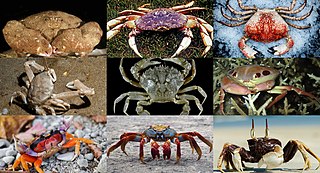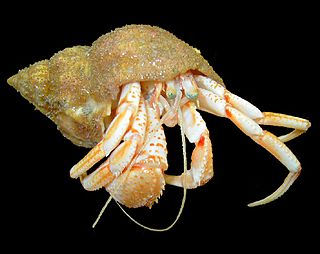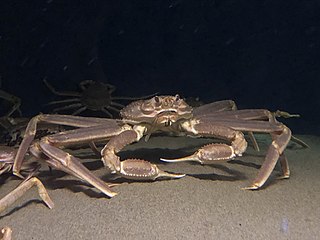
Crabs are decapod crustaceans of the infraorder Brachyura, which typically have a very short projecting tail-like abdomen, usually hidden entirely under the thorax. They live in all the world's oceans, in freshwater, and on land. They are generally covered with a thick exoskeleton. They generally have five pairs of legs, and they have pincer claws on the ends of the frontmost pair. They first appeared during the Jurassic period, around 200 million years ago.

The Japanese spider crab is a species of marine crab and is the biggest one that lives in the waters around Japan. At around 3.7 meters, it has the largest leg-span of any arthropod. The Japanese name for this species is taka-ashi-gani,, literally translating to “tall legs crab”. It goes through three main larval stages along with a prezoeal stage to grow to its great size.

Stenorhynchus seticornis, the yellowline arrow crab or simply arrow crab, is a species of marine crab.

Callinectes is a genus of crabs, containing 16 extant species, including the Atlantic blue crab, C. sapidus:

Maja brachydactyla is a species of crab in the family Majidae. It was initially described as a subspecies of M. squinado. A review of the species complex published in 1998 was able to differentiate between specimens from the Mediterranean Sea and those from the Atlantic Ocean, and concluded that the Atlantic specimens were a separate species, accepted as M. brachydactyla Balss, 1922.

Majidae is a family of crabs, comprising around 200 marine species inside 52 genera, with a carapace that is longer than it is broad, and which forms a point at the front. The legs can be very long in some species, leading to the name "spider crab". The exoskeleton is covered with bristles to which the crab attaches algae and other items to act as camouflage.

The Majoidea are a superfamily of crabs which includes the various spider crabs.

Notomithrax is a genus of crabs of the family Majidae, containing four species:

The Paguridae are a family of hermit crabs of the order Decapoda. The king crabs, Lithodidae, are now widely understood to be derived from deep within the Paguridae, with some authors placing their ancestors within the genus Pagurus.

Sesarma is a genus of terrestrial crabs endemic to the Americas.

Latreilliidae is a small family of crabs. They are relatively small, long-legged crabs found on soft bottoms at depths of up 700 metres (2,300 ft) in mostly tropical and subtemperate waters around the world. Their carapace is very small and doesn’t cover the bases of their legs, which protrude from the cephalothorax in a spider-like manner. The family and its type genus are named after Pierre André Latreille. The oldest known fossils from the Latreillidae have been dated to the middle of the Cretaceous period. It comprises seven extant species.

Mithraculus sculptus, the green clinging crab or emerald crab, is a species of crab in the family Majidae. It is a dark green colour and is found in tropical waters in the Caribbean Sea. It is sometimes kept in reef aquaria.
Actinotocarcinus is an extinct genus of Miocene crab, and is the only genus in the subfamily Actinotocarcininae of the family Epialtidae, though was originally classified in the family Majidae. Actinotocarcinus comprises two species, A. chidgeyi, and A. maclauchlani, both from Miocene-aged marine strata of New Zealand.
Maja capensis, the Agulhas spider crab, is a species of crab in the family Majidae.

Inachus phalangium, Leach's spider crab, is a species of crabs from the north-eastern Atlantic Ocean and Mediterranean Sea. It is up to 20.5 mm (0.81 in) wide, and is very similar to other species in the genus Inachus.

Chionoecetes opilio, a species of snow crab, also known as opilio crab or opies, is a predominantly epifaunal crustacean native to shelf depths in the northwest Atlantic Ocean and north Pacific Ocean. It is a well-known commercial species of Chionoecetes, often caught with traps or by trawling. Seven species are in the genus Chionoecetes, all of which bear the name "snow crab". C. opilio is related to C. bairdi, commonly known as the tanner crab, and other crab species found in the cold, northern oceans.
Libinia ferreirae is a species of tropical spider crab in the family Epialtidae. It is found on the seabed in shallow waters off the Atlantic coast of South America.

Pyromaia tuberculata is a species of crab in the family Inachoididae.

Cyclocoeloma is a genus of crabs in the family Majidae, containing the single species Cyclocoeloma tuberculata.

Mithracidae is a family of crustaceans belonging to the order Decapoda.
















